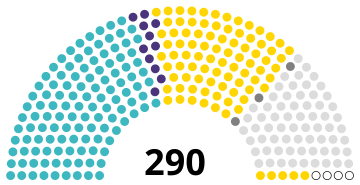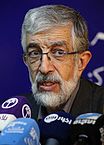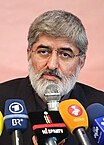| |||||||||||||||||||||||||||||||||||||
All 290 seats to the Islamic Consultative Assembly 146 seats are needed for a majority | |||||||||||||||||||||||||||||||||||||
|---|---|---|---|---|---|---|---|---|---|---|---|---|---|---|---|---|---|---|---|---|---|---|---|---|---|---|---|---|---|---|---|---|---|---|---|---|---|
| Turnout | 61.64% (first round)[1] 59% (second round)[2] | ||||||||||||||||||||||||||||||||||||
| |||||||||||||||||||||||||||||||||||||
 Composition of the Assembly following the election | |||||||||||||||||||||||||||||||||||||
| |||||||||||||||||||||||||||||||||||||
Parliamentary elections were held in Iran on 26 February 2016 to elect members of the Islamic Consultative Assembly for all seats in the 10th parliament in the Islamic Republic era and the 34th since the Persian Constitutional Revolution. A second round was held on 29 April 2016 for some constituencies where candidates failed to obtain the required minimum 25 percent of votes cast.[citation needed] The elected MPs served from 28 May 2016 to 27 May 2020.
The election was held as part of a general election which also elected members of the Assembly of Experts.[4] This election was the first time that both bodies were elected simultaneously.
There were 54,915,024 registered voters (in Iran, the voting age is 18). More than 12,000 people filed to run for office.[5] 5,200 candidates, mostly Reformists,[5] were rejected by the Guardian Council and 612 individuals withdrew.
- ^ "2016 Parliamentary Election". Retrieved 29 April 2016.
- ^ "اعلام میزان مشارکت مرحله دوم انتخابات". tabnak. Retrieved 30 April 2016.
- ^ a b c Ehteshami, Anoushiravan (2017). "Politics of the Islamic Republic". Iran: Stuck in Transition. The Contemporary Middle East. Taylor & Francis. p. 102. ISBN 9781351985451.
- ^ Rafsanjani May Run for the Top Position in the Leadership Assembly Archived 2014-10-25 at the Wayback Machine Rooz, 14 July 2014
- ^ a b "Elections in Iran: The great candidate cull: Choose any candidate you like—after the mullahs have excluded reformers". The Economist. 20 February 2016. Retrieved 20 February 2016.
Cite error: There are <ref group=lower-alpha> tags or {{efn}} templates on this page, but the references will not show without a {{reflist|group=lower-alpha}} template or {{notelist}} template (see the help page).


